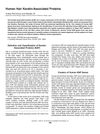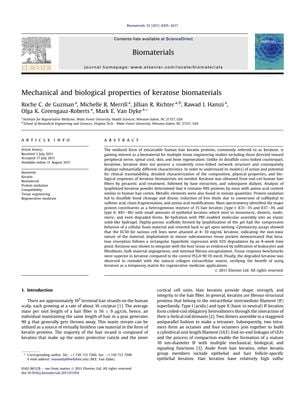TLDR Keratose, derived from human hair, is a non-toxic biomaterial good for tissue regeneration and integrates well with body tissues.
The document discusses keratose, an oxidized form of human hair keratin proteins, as a promising biomaterial for tissue engineering in nerve, spinal cord, skin, and bone regeneration. Keratose, which is obtained from human hair through chemical treatment, consists of 99% proteins and has a similar amino acid content to human hair cortex. It forms an elastic solid-like hydrogel when rehydrated and can be made into highly-porous scaffolds with cellular foam-like compression behavior. These scaffolds are non-toxic, as shown by cytotoxicity assays with an EC50 value of 8-10 mg/mL for various cell lines. In vivo studies in mice demonstrated that keratose is largely resorbed (92%) within 8 weeks and integrates well with host tissue, showing better tissue response benchmarks than the control PLGA 90:10 mesh. Keratose also remodeled with the natural collagen extracellular matrix, suggesting its utility as a temporary matrix for regenerative medicine.
49 citations
,
April 2010 in “International Journal of Cosmetic Science” Hair ages as the cuticle wears down, especially beyond 1 meter from the root, affecting its strength and shine.
517 citations
,
February 2010 in “Materials” Keratin from hair and wool is used in medical materials for healing and drug delivery.
 1398 citations
,
May 2008 in “Histochemistry and Cell Biology”
1398 citations
,
May 2008 in “Histochemistry and Cell Biology” Keratins are crucial for cell stability, wound healing, and cancer diagnosis.
177 citations
,
April 2008 in “Biomedical Materials” Human hair proteins can be used to create scaffolds that support cell growth for tissue engineering.
50 citations
,
December 2007 in “Journal of Biomedical Materials Research Part B Applied Biomaterials” Keratin-gelatin films improve skin graft success in dogs.
309 citations
,
October 2007 in “Biomaterials” Keratin from human hair helps nerves heal faster.
254 citations
,
January 2007 in “Chemical Society Reviews” Hair is a complex protein fiber with unique properties useful for developing hair products.
226 citations
,
January 2006 in “International review of cytology” Keratin-associated proteins are crucial for hair strength and structure.
 71 citations
,
August 2005 in “The journal of investigative dermatology. Symposium proceedings/The Journal of investigative dermatology symposium proceedings”
71 citations
,
August 2005 in “The journal of investigative dermatology. Symposium proceedings/The Journal of investigative dermatology symposium proceedings” Hair keratin-associated proteins are essential for strong hair, with over 80 genes showing specific patterns and variations among people.
252 citations
,
January 1991 in “Electron Microscopy Reviews”
36 citations
,
December 1991 in “Journal of Dermatological Science” Human nails contain both skin and hair keratins, each needing different extraction methods.


